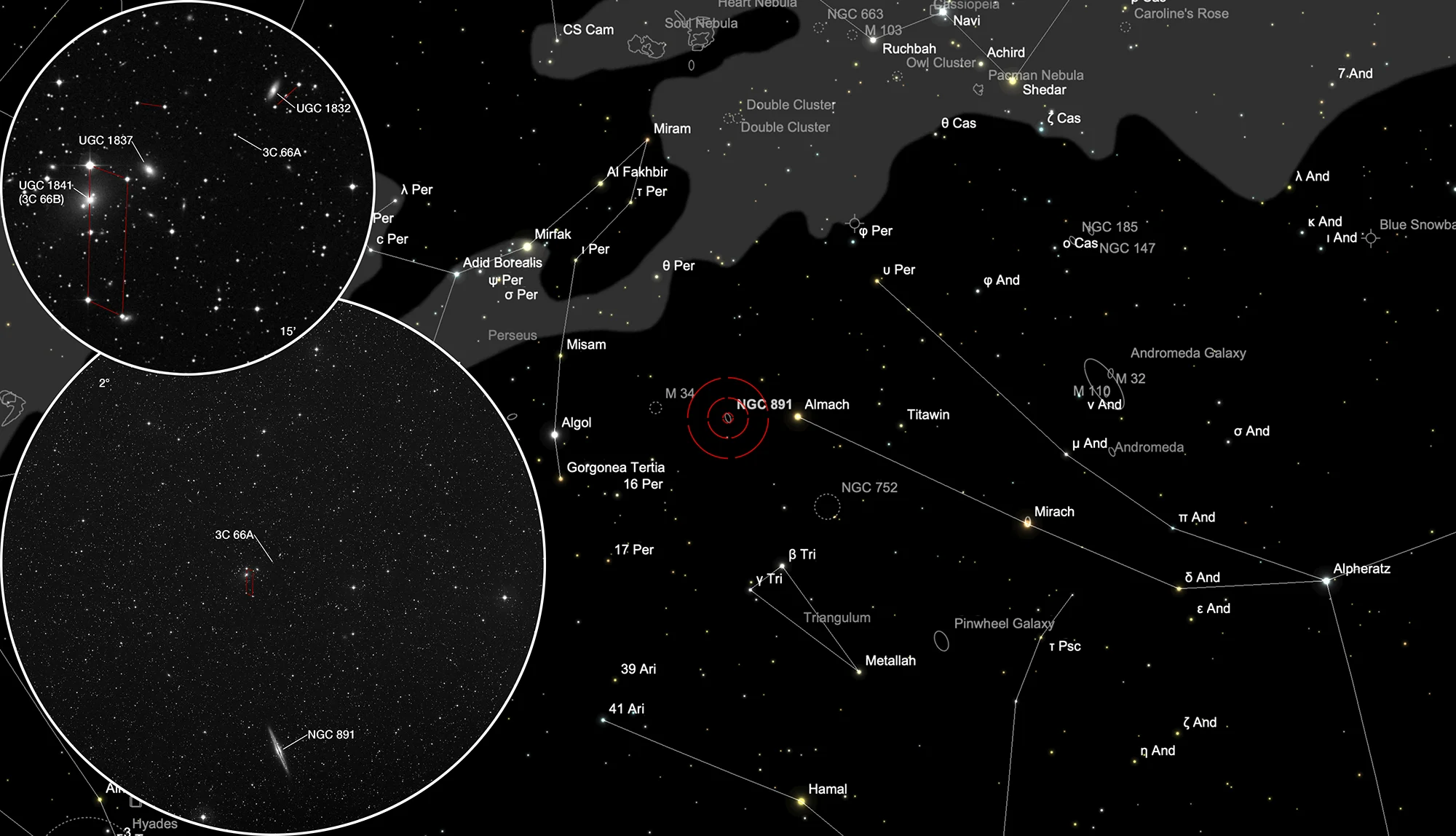Quasar 3C 66A
History
The radio source 3C 66 was discovered in 1959 during a survey with the Cambridge Four-Element Interferometer. The designation «3C» refers to the «Third Cambridge Catalogue of Radio Sources». Later, it was found that 3C 66 consists of two radio sources. The main source, 3C 66B, was identified with an elliptical galaxy, which later received the designation UGC 1841. The second radio source, 3C 66A, appeared to have no physical connection. It turned out to be not a star in our Milky Way but exhibiting a quasi-stellar object (QSO) spectrum. [662]
Physical Properties
3C 66A is a blazar, one of the most extreme subclasses of active galactic nuclei, whose relativistic jet is oriented towards our line of sight and emits radiation across the entire electromagnetic spectrum from radio to gamma rays. It belongs to the BL-Lac blazar class and exhibits non-periodic fluctuations in brightness that can occur within hours. Therefore, it must be a very compact object roughly the size of our solar system.
| Name | 3C 66A |
| Object Type | BL Lac |
| Right Ascension (J2000.0) | 02h 22m 40s |
| Declination (J2000.0) | +43° 02' 08" |
| Parallaxes | 0.062 mas |
| Radial velocity | 85318 km/s |
| Redshift z | 0.34 |
| Magnitudes | B 15.71; V 15.21; G 14.591449; R 14.5; J 12.635; H 11.88; K 11.151; g 15.605; r 15.112 |
| Identifiers | 0FGL J0222.6+4302; 1AGLR J0222+4305; 1ES 0219+42.8; 1FGL J0222.6+4302; 1FHL J0222.6+4302; 1FLE J0219+4256; 1REX J022239+4302.1; 1RXS J022239.1+430220; 2AGL J0221+4250; 2E 0219.5+4248; 2E 558; 2EG J0220+4228; 2FGL J0222.6+4302; 2FHL J0222.6+4301; 2MASS J02223961+4302078; 3C 66A; 3EG J0222+4253; 3FGL J0222.6+4301; 3FHL J0222.6+4302; 4FGL J0222.6+4302; 6C 021932+424742; 7C 021929.69+424830.00; 87GB 021932.0+424811; AAVSO 0216+42; AP J02223961+4302078; ATO J035.6650+43.0355; B3 0219+428A; BWE 0219+4248; CJF B0219+428; CLASS J022239.6086+430207.852; EGR J0223+4300; FL8Y J0222.6+4302; GB6 B0219+4248; GB6 J0222+4302; GRO J0222+42; Gaia DR1 339755071579064192; Gaia DR2 339755075874658560; Gaia DR3 339755075874658560; GeV J0223+4254; ICRF J022239.6+430207; IERS B0219+428; INTREF 110; IVS B0219+428; MAGIC J0223+403; MITG J022237+4301; MY 021929.5+430151.2; NVSS J022239+430208; PKS 0219+428; QSO B0219+4248; QSO B0219+428; QSO J0222+4302; QSO J0222+4302A; RORF 0219+428; TGSSADR J022239.2+430211; TIC 293121581; TeV J0222+430; VLSS J0222.6+4302; VLSSr J022239.4+430204; WISE J022239.60+430207.8; WISEA J022239.60+430207.8; ZTF J022239.60+430207.8; [BDW2002] q0219+4248; [DGT2001] B0219+428; [HB93] 0219+428; [IN88] 0219+428; [MGL2009] BZB J0222+4302; [MML2015] 5BZB J0222+4302; [N73] 3C 66A; [OR76] 0219+428; [S77] 59; [SDM85] 3CR 66A; [VV2000b] J022239.6+430208; [VV2003b] J022239.6+430208; [VV2006b] J022239.6+430208; [VV2010b] J022239.6+430208; [VV98b] J022239.6+430208; [W72] 0219+42; [WTW94] 0219+428 |
Data for the three nearby galaxies in the 15' Closeup:
| PGC | RA | Dec | Type | Dim | Btot | HRV | PA | Names |
|---|---|---|---|---|---|---|---|---|
| PGC 9029 | 02 22 31.2 | +43 03 53 | S | 1.1 x .5 | 15.3 | 163 | UGC 1832, MCG 7-5-45, CGCG 538-53 | |
| PGC 9051 | 02 22 58.4 | +43 00 43 | L | 1.2 x .9 | 14.9 | 6385 | 25 | UGC 1837, MCG 7-6-1, CGCG 538-55, CGCG 539-1 |
| PGC 9067 | 02 23 11.5 | +42 59 30 | C M | 3.0 x 3.0 | 14.6 | 6226 | UGC 1841, MCG 7-6-3, CGCG 538-57, CGCG 539-3, 5ZW 230, ANON 220+42 |
Finder Chart
To locate the quasar 3C 66A, follow these instructions: About 40 arcminutes north of the galaxy NGC 891, there is a rhomboid of four stars, within which the galaxy UGC 1841 is embedded. UGC 1837 is outside the rhomboid and hangs next to the corner star towards the quasar. Parallel to the north of the rhomboid, there are two faint stars which act as the first pointer to the quasar. The three faint stars next to UGC 1832 serve as the second pointer to the quasar. The quasar 3C 66A is located at the intersection point of these two lines. On 1 November it is in opposition to the Sun and culminates at local midnight. The constellation Andromeda is highest in the sky at night from June to March.
Visual Observation
300 mm Aperture: The quasar 3C 66A appears as a small dot, which is roughly as bright as the faintest of the three pointer stars. The quasar is said to be variable, and based on its current brightness, it appears to be closer to its maximum brightness. — 300 mm f/5 Hofheim Dobsonian, TV-Nagler-Zoom 6mm-3mm / 250x-500x / 0.22°-0.11°, Edelweissspitze 2571m ASL, 7. 10. 2007, SQM 21.53, Eduard von Bergen
